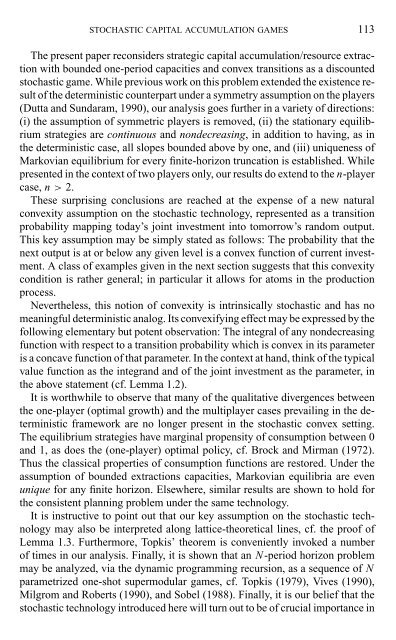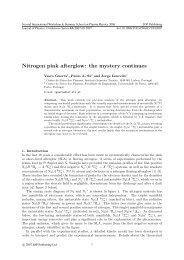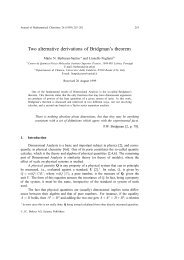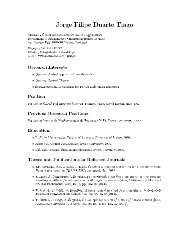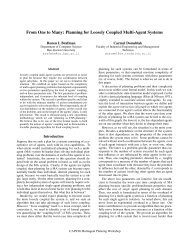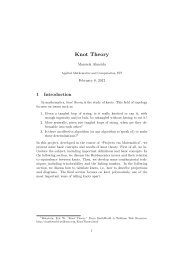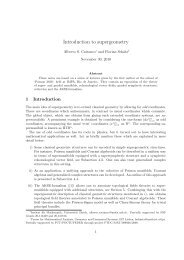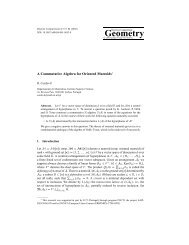Cournot Oligopoly and the Theory of Supermodular Games
Cournot Oligopoly and the Theory of Supermodular Games
Cournot Oligopoly and the Theory of Supermodular Games
Create successful ePaper yourself
Turn your PDF publications into a flip-book with our unique Google optimized e-Paper software.
STOCHASTIC CAPITAL ACCUMULATION GAMES 113The present paper reconsiders strategic capital accumulation/resource extractionwith bounded one-period capacities <strong>and</strong> convex transitions as a discountedstochastic game. While previous work on this problem extended <strong>the</strong> existence result<strong>of</strong> <strong>the</strong> deterministic counterpart under a symmetry assumption on <strong>the</strong> players(Dutta <strong>and</strong> Sundaram, 1990), our analysis goes fur<strong>the</strong>r in a variety <strong>of</strong> directions:(i) <strong>the</strong> assumption <strong>of</strong> symmetric players is removed, (ii) <strong>the</strong> stationary equilibriumstrategies are continuous <strong>and</strong> nondecreasing, in addition to having, as in<strong>the</strong> deterministic case, all slopes bounded above by one, <strong>and</strong> (iii) uniqueness <strong>of</strong>Markovian equilibrium for every finite-horizon truncation is established. Whilepresented in <strong>the</strong> context <strong>of</strong> two players only, our results do extend to <strong>the</strong> n-playercase, n > 2.These surprising conclusions are reached at <strong>the</strong> expense <strong>of</strong> a new naturalconvexity assumption on <strong>the</strong> stochastic technology, represented as a transitionprobability mapping today’s joint investment into tomorrow’s r<strong>and</strong>om output.This key assumption may be simply stated as follows: The probability that <strong>the</strong>next output is at or below any given level is a convex function <strong>of</strong> current investment.A class <strong>of</strong> examples given in <strong>the</strong> next section suggests that this convexitycondition is ra<strong>the</strong>r general; in particular it allows for atoms in <strong>the</strong> productionprocess.Never<strong>the</strong>less, this notion <strong>of</strong> convexity is intrinsically stochastic <strong>and</strong> has nomeaningful deterministic analog. Its convexifying effect may be expressed by <strong>the</strong>following elementary but potent observation: The integral <strong>of</strong> any nondecreasingfunction with respect to a transition probability which is convex in its parameteris a concave function <strong>of</strong> that parameter. In <strong>the</strong> context at h<strong>and</strong>, think <strong>of</strong> <strong>the</strong> typicalvalue function as <strong>the</strong> integr<strong>and</strong> <strong>and</strong> <strong>of</strong> <strong>the</strong> joint investment as <strong>the</strong> parameter, in<strong>the</strong> above statement (cf. Lemma 1.2).It is worthwhile to observe that many <strong>of</strong> <strong>the</strong> qualitative divergences between<strong>the</strong> one-player (optimal growth) <strong>and</strong> <strong>the</strong> multiplayer cases prevailing in <strong>the</strong> deterministicframework are no longer present in <strong>the</strong> stochastic convex setting.The equilibrium strategies have marginal propensity <strong>of</strong> consumption between 0<strong>and</strong> 1, as does <strong>the</strong> (one-player) optimal policy, cf. Brock <strong>and</strong> Mirman (1972).Thus <strong>the</strong> classical properties <strong>of</strong> consumption functions are restored. Under <strong>the</strong>assumption <strong>of</strong> bounded extractions capacities, Markovian equilibria are evenunique for any finite horizon. Elsewhere, similar results are shown to hold for<strong>the</strong> consistent planning problem under <strong>the</strong> same technology.It is instructive to point out that our key assumption on <strong>the</strong> stochastic technologymay also be interpreted along lattice-<strong>the</strong>oretical lines, cf. <strong>the</strong> pro<strong>of</strong> <strong>of</strong>Lemma 1.3. Fur<strong>the</strong>rmore, Topkis’ <strong>the</strong>orem is conveniently invoked a number<strong>of</strong> times in our analysis. Finally, it is shown that an N-period horizon problemmay be analyzed, via <strong>the</strong> dynamic programming recursion, as a sequence <strong>of</strong> Nparametrized one-shot supermodular games, cf. Topkis (1979), Vives (1990),Milgrom <strong>and</strong> Roberts (1990), <strong>and</strong> Sobel (1988). Finally, it is our belief that <strong>the</strong>stochastic technology introduced here will turn out to be <strong>of</strong> crucial importance in


